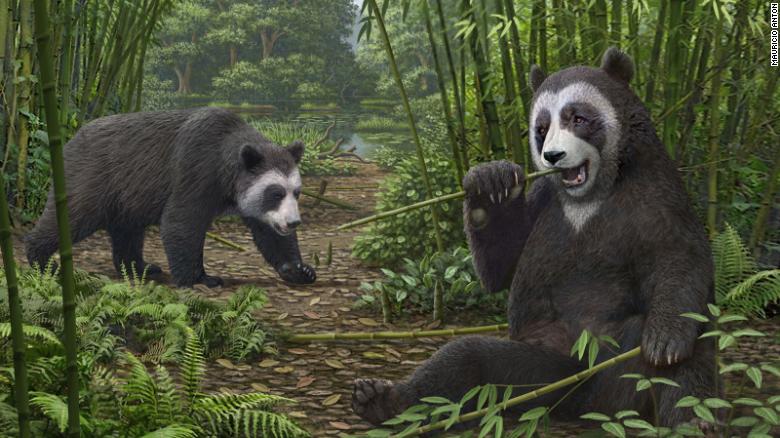Watch these baby pandas take their first steps 0:44
(CNN) --
Giant pandas have a notorious reputation for being picky eaters.
They only eat bamboo and spend 15 hours a day eating up to 45 kilograms of their favorite dish.
But their ancestors, like most bears, ate a much broader diet that included meat, and the restricted diet of today's pandas was thought to be a relatively recent evolution.
However, a new study finds that pandas' particular passion for bamboo may have originated at least six million years ago, possibly because the plant is widely available, year-round.
Model of a giant panda's paw grasping bamboo.
To survive solely on poorly nutritious bamboo, modern pandas (Ailuropoda melanoleuca) have developed a peculiar sixth finger, a kind of thumb that allows them to easily grasp bamboo stems and strip them of their leaves.
"Holding bamboo stalks tightly to crush them into morsels is perhaps the most crucial adaptation for consuming a prodigious amount of bamboo," said study author Xiaoming Wang, curator of vertebrate paleontology at the Natural History Museum of the Los Angeles County, in a statement.
The sparse panda fossil record meant it wasn't really understood how bears evolved this feature that has long baffled biologists.
Previous research had found evidence of this thumb-shaped structure from about 100,000 to 150,000 years ago.
advertising
Wang and his team identified much earlier evidence that pandas had an extra toe, and thus an exclusively bamboo-based diet, in the form of a fossilized toe dating to 6 to 7 million years ago.
The fossil, found in southwest China's Yunnan province, belonged to an ancestor of the panda known as Ailurarctos.
In the image, an artist's reconstruction of the ancestor of the giant panda Ailurarctos from the Shuitangba fossil site in Yunnan, China.
The new research was published Thursday in the journal Scientific Reports.
Although the giant panda's sixth toe is not as graceful or dexterous as human thumbs, the persistence of this "distinctive morphology" over millions of years suggests that it plays an essential role in survival, the study says.
Bacteria help pandas profit from being picky eaters, study says
evolutionary commitment
But what was especially puzzling to the scientists involved in the study was that this fossil structure was longer than those of modern giant pandas, which have a shorter, hooked sixth toe.
Wang and his colleagues believe that the shorter sixth toe of modern pandas is an evolutionary compromise between the need to handle bamboo and the need to walk and carry their bulky bodies.
"Five or six million years should be enough for the panda to develop longer false thumbs, but it seems that the evolutionary pressure of the need to travel and support its weight kept the 'thumb' short, strong enough to be useful without be big enough to get in the way," study co-author Denise Su, an associate professor in the School of Human Evolution and Social Change and a research scientist at the Arizona State University Institute on Human Origins, said in a statement.
EvolutionPandas













